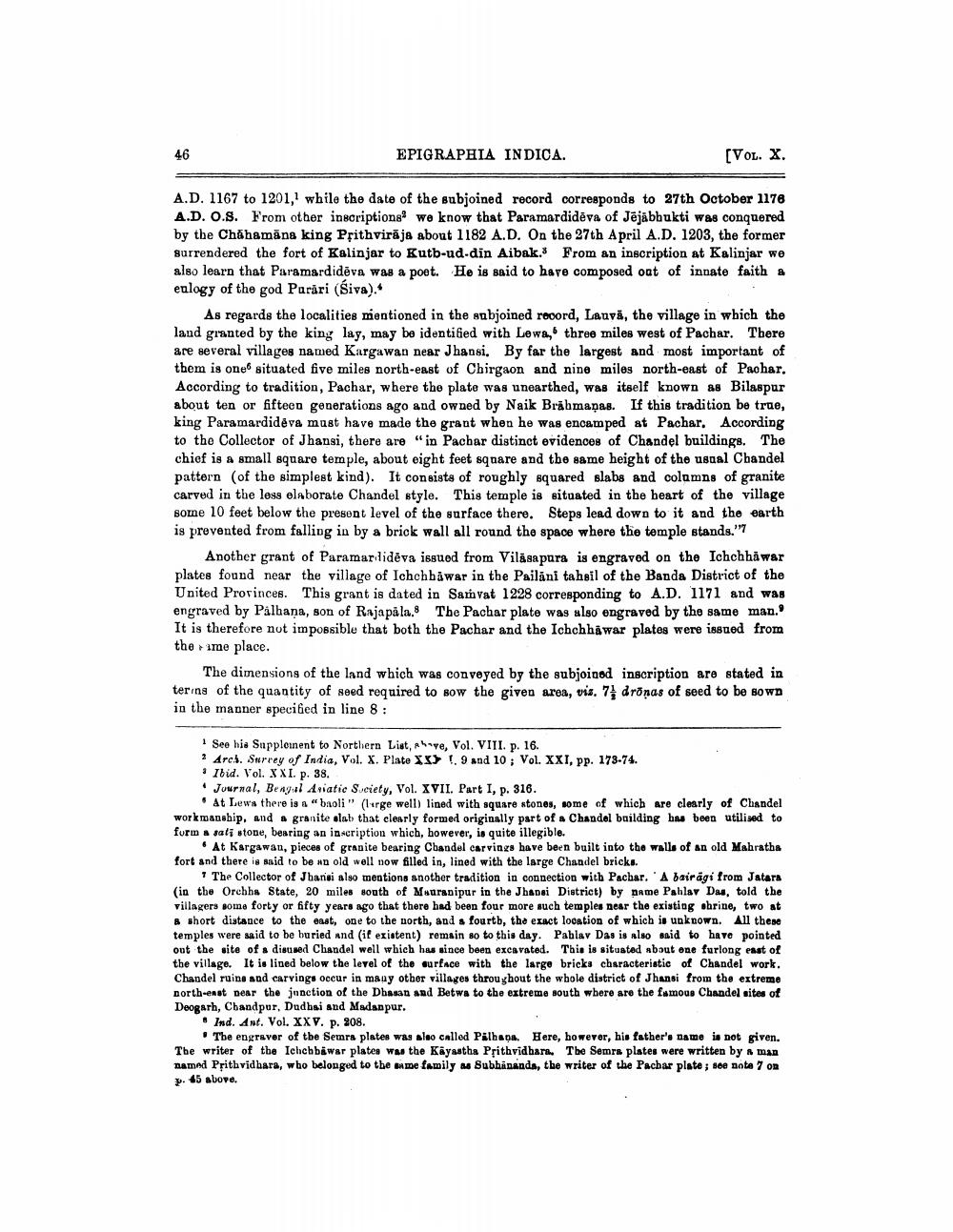________________
EPIGRAPHIA INDICA.
(VOL. X.
A.D. 1167 to 1201, while the date of the subjoined record corresponds to 27th October 1176 A.D. O.S. From other inscriptions we know that Paramardidēva of Jējābbukti was conquered by the Chāhamāna king Prithvirāja about 1182 A.D. On the 27th April A.D. 1203, the former surrendered the fort of Kalinjar to Kutb-ud-din Aibak. From an inscription at Kalinjar we also learn that Paramardidēva was a poet. He is said to have composed oat of innate faith a eology of the god Parári (Siva).
As regards the localities mentioned in the subjoined record, Lanvā, the village in which the land granted by the king lay, may be identified with Lewa, three miles west of Pachar. There are several villages named Kargawan near Jhansi. By far the largest and most important of them is one situated five miles north-east of Chirgaon and nine miles north-east of Pachar. According to tradition, Pachar, where the plate was unearthed, was itself known as Bilaspur about ten or fifteen generations ago and owned by Naik Brähmaņas. If this tradition be true, king Paramardidėva must have made the grant when he was encamped at Pachar. According to the Collector of Jhansi, there are "in Pachar distinct evidences of Chandel buildings. The chief is a small square temple, about eight feet square and the same height of the usoal Chandel pattern of the simplest kind). It consists of roughly squared slabs and columns of granite carved in the less elaborate Chandel style. This temple is situated in the heart of the village some 10 feet below the present level of the surface there. Stepg lead down to it and the earth is prevented from falling in by a brick wall all round the space where the temple stands."
Another grant of Paramariideva issued from Viläsapura is engraved on the Ichchhawar plates found near the village of Ichchbäwar in the Pailáni tahsil of the Banda District of the United Provinces. This grant is dated in Samvat 1228 corresponding to A.D. 1171 and was engraved by Palhana, son of Rajapala. The Pachar plate was also engraved by the same man. It is therefore not impossible that both the Pachar and the Ichchhawar plates were issued from the same place.
The dimensions of the land which was conveyed by the subjoinod inscription are stated in tering of the quantity of seed required to sow the given area, vis. 7) droņas of seed to be sown in the manner specified in line 8:
See hia Sappleinent to Northern List, Alave, Vol. VIII. p. 16. 2 Arch. Surrey of India, Vol. X. Plate XX) 1.9 and 10 ; Vol. XXI, pp. 173-74.
Ibid. Vol. XXI. p. 38.
Journal, Bengal Asiatic Society, Vol. XVII. Part I, p. 316.
• At Lewa there is a "baoli" (large well) lined with square stones, some of which are clearly of Chandel workmanship, and a granite slats that clearly formed originally part of a Chandal building has been utilised to furma sati stone, bearing an inscription which, however, is quite illegible.
At Kargawan, pieces of granite bearing Chandel carvings have been built into the walls of an old Mahratha fort and there is said to be an old well now filled in, lined with the large Chandel bricks.
The Collector of Jhansi also mentions another tradition in connection with Pachar. 'A bairāgi from Jatara (in the Orchha State, 20 miles south of Mauranipur in the Jhansi District) by name Pahlav Das, told the villagers some forty or fifty years ago that there had been four more such temples near the existing shrine, two at A short distance to the east, one to the north, and a fourth, the exact location of which is unknown. All these temples were said to be buried and (if existent) remain so to this day. Pablav Das is also said to have pointed out the site of a disused Chandel well which has since been excavated. This is situated about one furlong east of the village. It is lined below the level of the surface with the large bricks characteri Chandel ruins and carvings occur in many other villages throughout the whole district of Jhansi from the extreme north-east near the junction of the Dhasan and Betwa to the extreme south where are the famous Chandel sites of Deogarh, Chandpur, Dudhai and Madanpur.
. Ind. Ant. Vol. XXV. p. 208.
The engraver of the Semra plates was also called Pilbage. Here, however, his father's name is not given. The writer of the Ichchbiwar plates was the Kayastha Prithvidhara. The Semra plates were written by a man namad Prithvidhara, who belonged to the same family as Subhānanda, the writer of the Pachar plate; see note 7 on p. 45 above.




